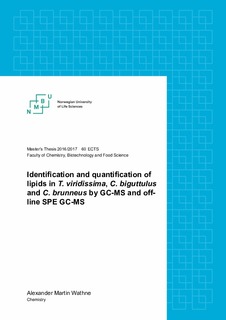| dc.contributor.advisor | Ekeberg, Dag | |
| dc.contributor.advisor | Devle, Hanne M. | |
| dc.contributor.author | Wathne, Alexander Martin | |
| dc.date.accessioned | 2017-09-12T08:06:08Z | |
| dc.date.available | 2017-09-12T08:06:08Z | |
| dc.date.issued | 2017 | |
| dc.identifier.uri | http://hdl.handle.net/11250/2454164 | |
| dc.description.abstract | The main objective of this study was to elucidate and quantitate the complete fatty acid profiles of the species Tettigonia viridissima, Chorthippus biguttulus and Chorthippus brunneus, all belonging to the order Orthoptera. Insects are already a staple food in many parts of Africa, South America and Asia, and have garnered increased attention in the West during the last few decades. The beneficial amino acid and fatty acid profiles of insects could make them a viable alternative to beef, poultry and fish in the West in the coming decades due to the global, exponential population growth. Previous studies on the fatty acids of insects have been mostly focused on species whose habitat is located in more tropical climates. As a result, this study was conducted on three species commonly found in Norway, and whose combined habitats range throughout Scandinavia, continental Europe, temperate Asia and parts of North Africa.
The complete fatty acid profiles of all species were identified and quantitated using gas chromatography coupled to a three-sector mass spectrometer. The analytical method had previously been established, tested and validated in our laboratory several years prior to this study. Fatty acids extracted from the insects, by use of solvents, were derivatized into fatty acid methyl esters prior to analyses. Off-line solid-phase extraction was also implemented for the fatty acids from T. viridissima to quantitate the contents of neutral lipids, polar lipids and free fatty acids. The presence of fatty acids such as linoleic acid, α-linolenic acid, arachidonic acid, eicosapentaenoic acid and docosahexaenoic acid were subsequently subjected to discussion to evaluate the potential of the species as human food, and impact on human health.
In the comparative study, T. viridissima was found to contain 10.4% fatty acids of dry weight, Chorthippus contained 6.14%. Both contained comparatively equal amounts of saturated fatty acids (31.1 and 32.7%), while Chorthippus was significantly richer in polyunsaturated fatty acids (42.1%) than T. viridissima (33.0%). Furthermore, the essential fatty acids linoleic acid and α-linolenic acid were abundant in both, but Chorthippus exhibited by far the highest contents of the latter (30.7%). The results suggested that both T. viridissima and Chorthippus contained nutritionally beneficial FA compositions, however, Chorthippus had a more favorable n-6/n-3 ratio of the two. | nb_NO |
| dc.description.abstract | Hovedmålet med denne studien var å identifisere og kvantifisere de komplette fettsyreprofilene til artene Tettigonia viridissima, Chorthippus biguttulus og Chorthippus brunneus, der alle tilhører insektordenen Orthoptera. Insekter er allerede et fast innslag i dietten mange steder i Afrika, Sør-Amerika og Asia, og har de siste tiårene opplevd en fornyet interesse i Vesten. De gunstige amino-, og fettsyreprofilene til insekter kan gjøre dem til et aktuelt alternativ til storfe, fjærfe og fisk i Vesten de kommende tiårene grunnet den globale, eksponentielle befolkningsveksten. Tidligere studier som har omhandlet fettsyrer i insekter har hovedsakelig fokusert på arter med utbredelse i mer tropiske strøk. Derfor ble denne studien utført på tre arter som er utbredt i Norge, Skandinavia forøvrig, kontinentale Europa, tempererte Asia, og deler av Nord-Afrika.
De komplette fettsyreprofilene for alle artene ble identifisert og kvantifisert ved bruk av en gasskromatograf koplet til et tre-sektor massespektrometer. Den analytiske metoden tatt i bruk har tidligere blitt etablert, testet og validert i vårt laboratorium flere år før denne studien fant sted. Fettsyrene som ble utvunnet fra insektene, ved bruk av løsningsmidler, ble derivatisert videre til fettsyremetylestere før analysene. Fast-faseekstraksjon ble også inkorporert for fettsyrene fra T. viridissima, for å kvantifisere forekomstene av nøytrale lipider, polare lipider og frie fettsyrer. Forekomstene av fettsyrene linolsyre, α-linolensyre, arakidonsyre, icosapentaensyre og docosahexaensyre ble i etterkant benyttet i diskusjonen for å evaluere potensialet til alle artene som menneskelig føde, samt innvirkning på menneskelig helse.
I den sammenliknende studien ble fettsyreinnholdet til T. viridissima funnet å være 10,4% av tørrvekten. Chorthippus inneholdt derimot 6,14%. Begge inneholdt omtrentlig like mengder mettede fettsyrer (31,1 og 32,7%), men Chorthippus hadde betydelig høyere innehold av flerumettede fettsyrer (42,1%) enn T. viridissima (33.0%). De essensielle fettsyrene linolsyre og α-linolensyre var tilstedeværende i rike mengder i begge arter, men forekomsten av sistnevnte var betydelig høyere i Chorthippus (30,7%). Både T. viridissima og Chorthippus hadde en gunstig fettsyreprofil fra et ernæringsmessig perspektiv, men Chorthippus hadde utelukkende den mest gunstige n-6/n-3 ratioen av de to. | nb_NO |
| dc.language.iso | eng | nb_NO |
| dc.publisher | Norwegian University of Life Sciences, Ås | nb_NO |
| dc.rights | Attribution-NonCommercial-NoDerivatives 4.0 Internasjonal | * |
| dc.rights.uri | http://creativecommons.org/licenses/by-nc-nd/4.0/deed.no | * |
| dc.subject | FAME | nb_NO |
| dc.subject | GC-MS | nb_NO |
| dc.subject | Orthoptera | nb_NO |
| dc.subject | Lipids | nb_NO |
| dc.subject | SPE | nb_NO |
| dc.title | Identification and quantification of lipids in T. viridissima, C. biguttulus and C. brunneus by GC-MS and off-line SPE GC MS | nb_NO |
| dc.type | Master thesis | nb_NO |
| dc.description.localcode | M-KJEMI | nb_NO |

